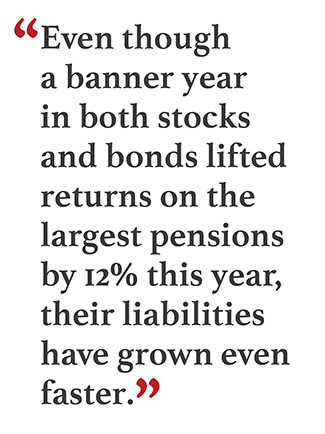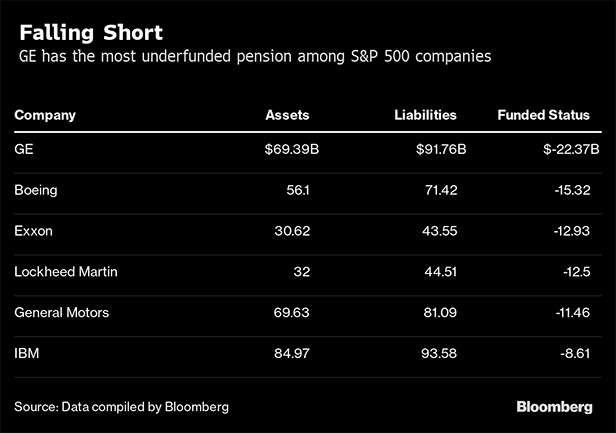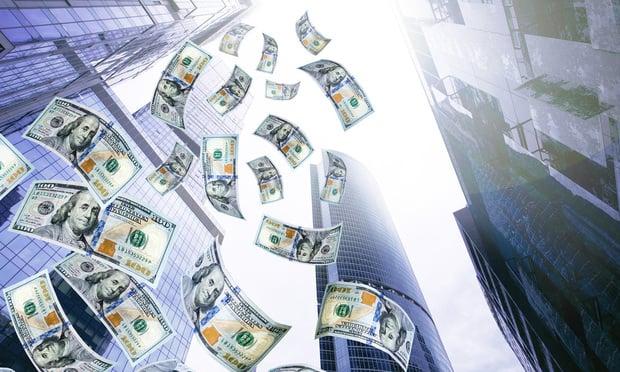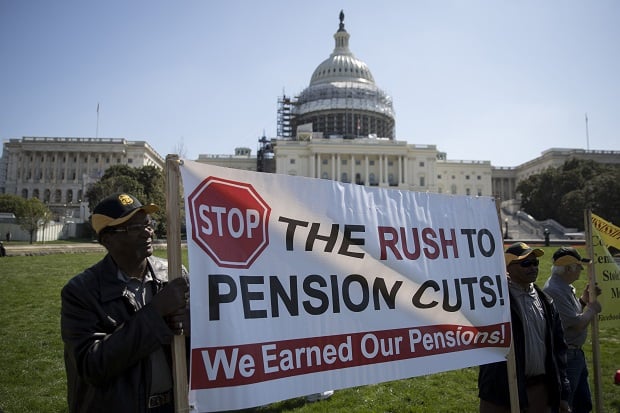General Electric Co.'s gaping pension deficit certainly standsout for its size. But the company is hardly the only one at risk ofpotentially shortchanging some employees come retirement.
|All across corporate America, underfunded pensions have becomethe norm. Even now, a decade after the financial crisis, thelargest plans face a shortfall of $269 billion, right about wherethey were 10 years ago. Years of low interest rates have largelyoffset gains in the stock market. Companies haven't helped mattersby lavishing money on shareholder rewards and clinging toassumptions about returns that proved to be too rosy.
| The situation isn't likely toimprove any time soon, particularly if interest rates keep falling.Even though a banner year in both stocks and bonds lifted returnson the largest pensions by 12 percent this year, their liabilitieshave grown even faster, according to consulting firm Milliman. Andwhile GE's move to freezebenefits and set aside money will help trim its $22.4 billionpension shortfall by as much as $8 billion, CEO Larry Culp saidlast month that low rates could boost those same liabilities byroughly $7 billion.
The situation isn't likely toimprove any time soon, particularly if interest rates keep falling.Even though a banner year in both stocks and bonds lifted returnson the largest pensions by 12 percent this year, their liabilitieshave grown even faster, according to consulting firm Milliman. Andwhile GE's move to freezebenefits and set aside money will help trim its $22.4 billionpension shortfall by as much as $8 billion, CEO Larry Culp saidlast month that low rates could boost those same liabilities byroughly $7 billion.
In other words, unless companies take even more drastic steps,they're currently doing little better than treading water.
|"Plan sponsors are getting concerned that we've had a historicequity run in the market and they're still sitting on underfundedpension positions," said Steve Keating, managing director at BCGPension Risk Consultants.
|Part of it has to do with what's called the discount rate, whichfor corporate pensions typically corresponds to yields on highlyrated corporate bonds.
|Simply put, the lower the discount rate, the less a plan assumesit will earn over time. That means the plan needs to set aside moremoney today to cover retirement benefits a company has promised topay its employees in the years and decades to come. In August, thediscount rate fell to an average of 2.95 percent, the lowest levelin the 19-year history of Milliman's pension fundingindex.
|Defined-benefit plans have largely disappeared from view in thepast couple of decades as companies have embraceddefined-contribution plans like 401(k)s. Employers can opt tocontribute to those defined-contribution plans, but it's theemployees who are responsible for choosing the right investmentsand who are solely on the hook if those investments farepoorly.
|Nevertheless, there are plenty of older employees and retireeswho are still owed, collectively, tens of billions ofdollars in benefits that companies have failed to adequatelyfund.
|GE's predicament underscores the scope of the problem. OnMonday, the company said it would freeze pension benefits for morethan 20,000 employees and set aside as much as $5 billion to coverfuture obligations. (For those who didn't grow up with pensions,"freezing" benefits essentially means that whatever employees haveaccrued thus far is what they will get from the plan, and no more, regardlessof how many more years they work for that company.) And for GE,that helps reduce the amount they'll ultimately need to payout.
|Yet at the end of 2018, GE owed benefits to at least 600,000people worldwide, amounting to nearly $92 billion in futurepayouts. Globally, its pension plans had just $69 billion inassets.
|
To be fair, many companies probably didn't expect interestrates, which fell to rock-bottom levels as a result of the FederalReserve's crisis-era monetary policies, to stay so low. Outside ofbrief periods during parts of 2013 and 2018, when bond yieldslooked like they were finally about to return to historical norms,they've kept falling. That's had real-world consequences forretirees who not only rely on a fixed income, but are living longeras well.
|"Even though the equity markets have done pretty well this year,it's been hard for them to make up ground" because of low rates,said Beth Ashmore, a managing director for retirement at WillisTowers Watson Plc. Despite the stock market run since the crisis,"funding levels really haven't recovered as much as everybody wouldhave hoped."
|While many companies have plenty of money to plug orsignificantly reduce their pension deficits if they want to rightnow, others do not. GE has $32 billion in cash and equivalents,enough to wipe out its deficit (setting aside, of course, its manyother debt obligations.) On the other hand, Delta Air Lines Inc.has $6.4 billion in unfunded liabilities and just $2 billion incash.
|Some have sought to transfer their pension liabilities to lifeinsurers. The market for single premium buyouts reached $26 billionlast year, according to data from industrygroup LIMRA. Earlier this year, Lockheed Martin Corp. said that itstruck deals with Prudential Financial Inc. and Athene Holding Ltd.to transfer billions in pension obligations.
|Others like United Parcel Service Inc. have taken advantage oflow borrowing costs to finance their pension contributions in the debtmarkets. Chipping away at a shortfall can help companies cutback on payments to the Pension Benefit Guaranty Corp.(PBGC), a government agency that helps backstop plans. Theagency has been ratcheting up rates for companies that maintainpension deficits in recent years, in an effort to get them to plugthose shortfalls.
|"I think CFOs, in some ways, want to take control and start tothoughtfully reduce the size of their pension plan over time,"BCG's Keating said.
|Whatever the case, it's often the employees who end up losingout. Freezing pensions has become a more popular strategy forcompanies in recent years. A decade ago, about 20 percent ofFortune 500 companies with pension plans in place since 1998 hadfrozen their plans,according to Willis Towers Watson. Since then, that figure hasswelled to 42 percent.
|"In a situation of 'corporate battlefield surgery,' this tendsto be a typical, if unfortunate, casualty," said Julian Mitchell,an analyst at Barclays Plc.
|–With assistance from BrandonKochkodin.
|Copyright 2019 Bloomberg. All rightsreserved. This material may not be published, broadcast, rewritten,or redistributed.
Complete your profile to continue reading and get FREE access to Treasury & Risk, part of your ALM digital membership.
Your access to unlimited Treasury & Risk content isn’t changing.
Once you are an ALM digital member, you’ll receive:
- Critical Treasury & Risk information including in-depth analysis of treasury and finance best practices, case studies with corporate innovators, informative newsletters, educational webcasts and videos, and resources from industry leaders.
- Exclusive discounts on ALM and Treasury & Risk events.
- Access to other award-winning ALM websites including PropertyCasualty360.com and Law.com.
*May exclude premium content
Already have an account? Sign In
© 2024 ALM Global, LLC, All Rights Reserved. Request academic re-use from www.copyright.com. All other uses, submit a request to [email protected]. For more information visit Asset & Logo Licensing.







